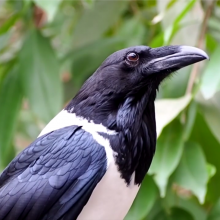Corvus albus

Conservation Status:
Least Concern on the IUCN Red List
Range:
Sub-Saharan Africa
Habitat:
Grasslands, savannahs, mountainous regions, riverbanks, shorelines, and open, lightly wooded expanses near small villages.
The African pied crow is black with white on its chest. The term "pied" indicates that they have distinct patches of feathers with well-defined edges. Interestingly, they are more closely related to the common raven and the Somali crow than to other crow species!
Being omnivores, African Pied Crows consume a variety of insects, small reptiles, small rodents, eggs, grains, nuts, small and young birds, as well as carrion (scraps and carcasses). They have even been observed preying on fruit bats.
These crows are typically found in pairs or small groups and have an extensive foraging range. Like most crows, pied crows display impressive problem-solving abilities and can employ tools to achieve their goals, such as using rocks or branches to crack open nuts or eggs. They have even been observed placing nuts in front of vehicles and collecting the crushed pieces afterwards.
Pied Crow nests can be found in solitary tall trees. The female lays 4-5 eggs from September to November, which have a green color with brown spots and take around 18-19 days to hatch. While the female incubates the eggs and covers them when she leaves to search for food, both the male and female participate in raising the chicks, which fledge after approximately 45 days.
African Pied Crows are rated as Least Concern on the IUCN Red List due to their stable population, broad range of habitats and food sources, and the absence of known threats.
